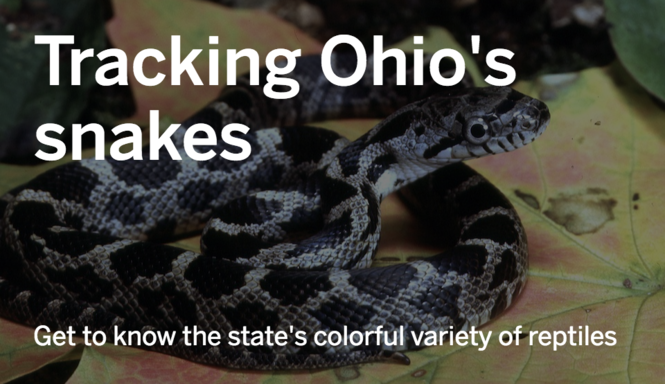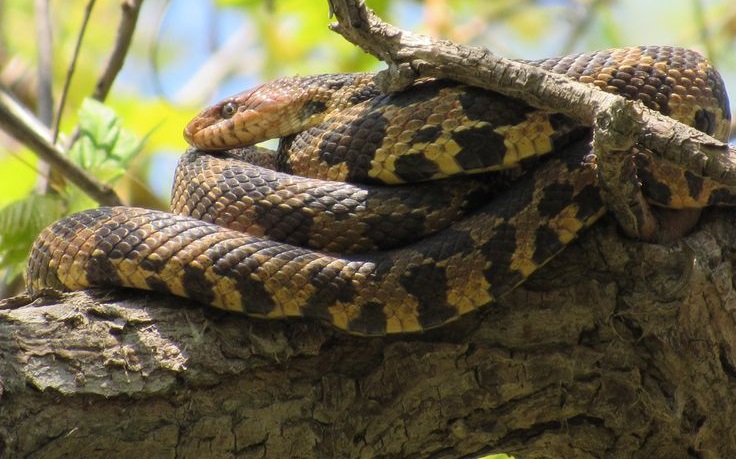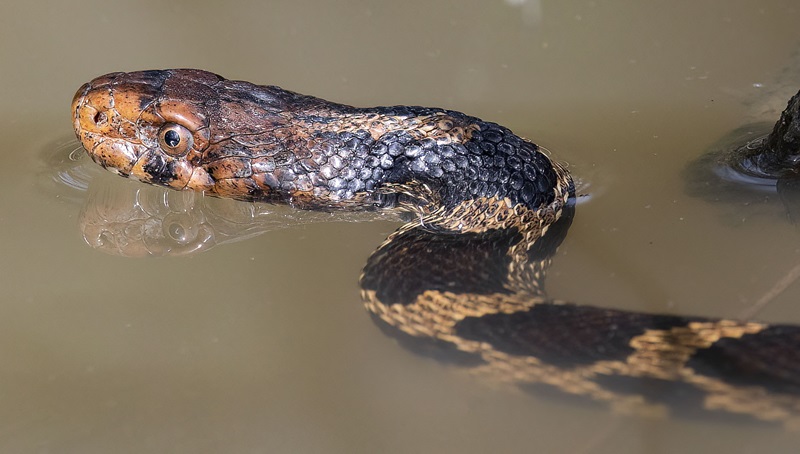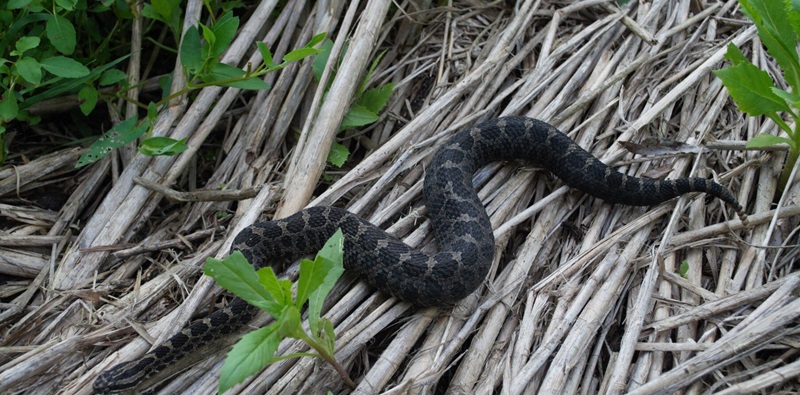Ohio is home to a diverse range of snake species, with a total of 10 different types found throughout the state. These snakes vary in size, color, and habitat preferences, making them fascinating creatures to study and observe in the wild. Some of the most commonly spotted species in Ohio include the Eastern garter snake, Eastern rat snake, and Northern water snake.
These snakes can be found in a variety of environments, from forests and fields to wetlands and streams. By learning to identify these different species, residents of Ohio can gain a greater appreciation for the rich biodiversity that exists in their state.
One of the most iconic snake species in Ohio is the Eastern garter snake. These snakes are known for their distinctive coloration, which includes a pattern of stripes running down their bodies. Eastern garter snakes can be found in a wide range of habitats, from suburban gardens to wooded areas. They are non-venomous and play an important role in controlling pest populations, making them a beneficial species to have around.
Another common snake species in Ohio is the Eastern rat snake. These snakes are much larger than garter snakes, with adults reaching lengths of up to six feet. Eastern rat snakes are excellent climbers and can often be found in trees or on rocky outcroppings. They are proficient hunters, feeding on a variety of small mammals, birds, and eggs. Despite their intimidating size, Eastern rat snakes are non-venomous and pose no threat to humans.
The Northern water snake is another snake species that is frequently encountered in Ohio. As their name suggests, these snakes are often found near bodies of water, such as lakes, rivers, and streams. Northern water snakes are excellent swimmers and can often be seen basking on rocks or logs near the water’s edge. While they are not venomous, Northern water snakes can be aggressive when threatened and will not hesitate to defend themselves if provoked.
In addition to these three species, Ohio is also home to several other snake species, including the Eastern milk snake, Eastern ribbon snake, and Black racer. Each of these species has its own unique characteristics and behaviors, making them fascinating subjects for observation and study. By familiarizing themselves with the different snake species found in Ohio, residents can better appreciate the biodiversity that exists in their state and work to protect these important creatures and their habitats.
Overall, Ohio’s snake diversity is a testament to the state’s rich natural heritage. By learning to identify and appreciate the various snake species that call Ohio home, residents can gain a greater understanding of the importance of preserving and protecting the state’s ecosystems. Whether encountered in a backyard garden or a remote wilderness area, Ohio’s snakes are an integral part of the state’s diverse wildlife community.

Copperhead bites are rarely fatal, although they can cause significant pain and discomfort. These snakes are not typically aggressive and will usually only strike if they feel threatened or cornered. Copperheads are responsible for the majority of snake bites in the United States, but most of these bites are not serious. In fact, only a small percentage of copperhead bites result in severe symptoms or complications.
However, it is still important to seek medical attention if bitten by a copperhead, as some individuals may have allergic reactions or other complications that require treatment. The venom of a copperhead is not as potent as that of some other snake species, which is why fatalities are rare.
Symptoms of a copperhead bite may include swelling, redness, pain, and bruising at the site of the bite, as well as nausea, vomiting, and weakness. In some cases, individuals may experience difficulty breathing or a rapid heartbeat. It is important to remain calm if bitten by a copperhead and seek medical help as soon as possible.
Most people recover fully from copperhead bites with appropriate medical treatment, which may include antivenom therapy and pain management. It is also important to take precautions to avoid snake bites in the first place, such as wearing appropriate footwear and clothing when hiking or camping in areas where copperheads are known to inhabit. By being aware of the risks and taking necessary precautions, individuals can minimize the chances of being bitten by a copperhead and reduce the likelihood of serious complications.
The Eastern Massasauga Rattlesnake is a rare and elusive species that is widely scattered throughout its range, making it seldom seen by humans. Despite its intimidating reputation, this small rattlesnake is actually quite shy and typically avoids confrontation with humans. Its preferred habitat includes wetlands, marshes, and grasslands, where it can find ample prey such as small mammals and birds.
Due to habitat loss and fragmentation, the Eastern Massasauga Rattlesnake’s population has been declining in recent years, leading to its classification as a threatened species in many states. Efforts are being made to protect and conserve this important predator, including habitat restoration and public education initiatives to raise awareness about the importance of coexisting with these fascinating creatures.
While encounters with the Eastern Massasauga Rattlesnake are rare, it is important to remember that they play a vital role in maintaining the balance of ecosystems and should be respected and protected in their natural habitats. By working together to conserve these unique reptiles, we can ensure that future generations will have the opportunity to appreciate their beauty and importance in the natural world.
Timber rattlesnakes are widely regarded as one of the most dangerous snake species in North America. These venomous snakes are known for their potent venom and aggressive nature when threatened. Their venom is highly toxic and can cause severe tissue damage and even death in humans if not treated promptly.
Timber rattlesnakes are also known for their distinctive warning signal — the rattling sound they make with their tail before striking. This warning gives potential threats a chance to retreat and avoid confrontation with these deadly predators.
Despite their dangerous reputation, timber rattlesnakes play a crucial role in the ecosystem as top predators, helping to control rodent populations and maintain ecological balance. However, encounters with timber rattlesnakes should be approached with caution and respect, as their venomous bite can have serious consequences for humans. It is important to educate the public about the risks associated with timber rattlesnakes and how to safely coexist with these fascinating but dangerous creatures.

Queensnakes are commonly found along shallow waterways, such as streams, creeks, and rivers. These habitats provide the perfect environment for the queensnake to thrive, as they are skilled swimmers and are able to easily navigate through the water to hunt for their prey.
The shallow waterways also offer plenty of hiding spots for the queensnake to take cover and avoid predators. In addition, the slow-moving water allows the queensnake to easily catch their favorite prey, such as small fish, amphibians, and invertebrates.
The queensnake’s habitat along shallow waterways also provides ample opportunities for basking in the sun, as they are cold-blooded reptiles that rely on external sources of heat to regulate their body temperature. Overall, the queensnake’s habitat along shallow waterways is essential for their survival and plays a crucial role in maintaining the balance of the ecosystem. It is important to protect these habitats to ensure the continued existence of the queensnake and other species that rely on them for their livelihood.
Conservation efforts should focus on preserving and restoring the natural habitats of the queensnake, as well as implementing measures to mitigate the threats that they face in their environment. By working together to protect these important habitats, we can help ensure the long-term survival of the queensnake and other species that call these shallow waterways home.
Kirtland’s snake, a small and elusive reptile native to the eastern United States, is known for its secretive nature and ability to avoid detection. Despite being relatively common in certain regions, spotting a Kirtland’s snake in the wild can be a rare and exciting experience for naturalists and herpetologists alike.
With its distinctive red and black striped pattern, this snake blends seamlessly into its natural habitat, making it difficult to spot among the undergrowth and leaf litter. In addition to its excellent camouflage, Kirtland’s snake is also adept at hiding in burrows and crevices, further complicating efforts to locate and study this species.
As a result, researchers and conservationists face significant challenges when it comes to monitoring and protecting the populations of Kirtland’s snakes in the wild. Despite their elusiveness, these snakes play a crucial role in maintaining the balance of their ecosystems, preying on small mammals and insects while serving as prey for larger predators.
To ensure the continued survival of Kirtland’s snakes, it is essential for conservation efforts to focus on preserving and restoring their natural habitats, as well as raising awareness about the importance of these often overlooked reptiles. By working together to protect and conserve Kirtland’s snakes and their habitats, we can help ensure that future generations will have the opportunity to observe and appreciate these fascinating creatures in the wild.

Brownsnakes, a species of snake found in North America, have a unique defense mechanism that involves the use of musk to ward off potential predators. When threatened, brownsnakes will release a foul-smelling musk from glands near their tail, creating a strong odor that is unpleasant to predators. This musk serves as a deterrent, making the snake less appetizing to predators and giving it a chance to escape unharmed. While some may view this defense mechanism as unsavory, it is an effective survival strategy that has allowed brownsnakes to thrive in their natural habitat.
By using musk as a defense, brownsnakes are able to protect themselves from harm and increase their chances of survival in the wild. This adaptation demonstrates the ingenuity and resourcefulness of these fascinating creatures, showcasing the ways in which they have evolved to overcome challenges and thrive in their environment. Overall, the use of musk by brownsnakes as a defense mechanism is a natural and effective way for these creatures to protect themselves and ensure their survival in the wild.
The hog-nosed snake is known for its incredible acting abilities in the animal kingdom. This species of snake has a unique defense mechanism that involves playing dead when threatened by predators. When confronted with danger, the hog-nosed snake will flatten its body, open its mouth, and release a foul-smelling musk to deter potential threats.
It will then roll onto its back and lie motionless, with its tongue hanging out and eyes glazed over, in a convincing act of death. This behavior is so convincing that even experienced predators, such as birds of prey and mammals, are often fooled into thinking the snake is truly deceased.
The hog-nosed snake’s natural acting abilities not only help it to avoid being eaten but also serve as a means of self-preservation in the wild. By pretending to be dead, this species of snake is able to buy time and wait for the threat to pass before resuming its normal activities. The hog-nosed snake’s remarkable acting skills are a testament to the ingenuity and adaptability of nature, showcasing the incredible ways in which animals have evolved to survive in their environments.
The Northern Red-Bellied Snake is known to be one of the smallest snake species in North America, typically measuring around 10-16 inches in length. Despite its small size, this snake is a fascinating creature with its distinctive red coloring on its belly and dark brown or black scales on its back. Found primarily in the northeastern United States and parts of Canada, the Northern Red-Bellied Snake is a non-venomous species that preys on small insects, worms, and slugs.
Due to its diminutive size, this snake is often overlooked or mistaken for a juvenile snake of a different species. However, the Northern Red-Bellied Snake plays an important role in its ecosystem as a predator of pests and a food source for larger predators. Its small size also allows it to navigate through tight spaces and burrows in search of food and shelter. Despite its small size, the Northern Red-Bellied Snake is a resilient and adaptable species that has managed to survive and thrive in various habitats. Its presence in the wild serves as a reminder of the diversity and beauty of the natural world.
The Eastern Smooth Earthsnake is a species known for its secretive nature. These small, non-venomous snakes are often found hiding under rocks, logs, or in burrows, making them difficult to spot in the wild. Their elusive behavior and cryptic coloration help them blend in seamlessly with their surroundings, allowing them to avoid detection by predators and humans alike. Despite their discreet nature, Eastern Smooth Earthsnakes play an important role in their ecosystems as they help control insect and small rodent populations.
Their secretive habits also serve as a defense mechanism against potential threats, allowing them to stay safe and avoid conflict. While some may view their elusive behavior as mysterious or even suspicious, it is simply a natural adaptation that has helped Eastern Smooth Earthsnakes survive and thrive in their environments for countless generations. So, while they may not be the most visible or well-known species, these secretive snakes play a crucial role in maintaining the delicate balance of their ecosystems.

Ring-necked snakes are fascinating creatures that are most active during the night. These snakes are known for their beautiful ring patterns around their necks, which is where they get their name from. Ring-necked snakes are small and slender, typically measuring around 10-15 inches in length.
They are primarily nocturnal, meaning they are most active at night when the temperatures are cooler. During the day, ring-necked snakes can be found hiding under rocks, logs, or debris to stay cool and avoid predators. They are skilled hunters, preying on small insects, worms, and other invertebrates. Ring-necked snakes are non-venomous and rely on their small size and camouflage to avoid potential threats.
One interesting behavior of ring-necked snakes is their defensive mechanism when they feel threatened. When threatened, these snakes will curl up their bodies, expose their bright orange or yellow undersides, and release a foul-smelling musk as a deterrent to predators. Despite their small size, ring-necked snakes are important members of their ecosystems, helping to control insect populations and contributing to the overall balance of their habitats. They are commonly found in a variety of habitats, including forests, grasslands, and wetlands across North America.
Overall, ring-necked snakes are fascinating creatures that play a vital role in their ecosystems. Their unique behaviors and adaptations make them well-suited for their nocturnal lifestyle. By staying active at night, ring-necked snakes are able to avoid the intense heat of the day and maximize their chances of finding food. These snakes may not be as well-known as other species, but they are certainly worth learning more about for their interesting behaviors and important ecological roles.